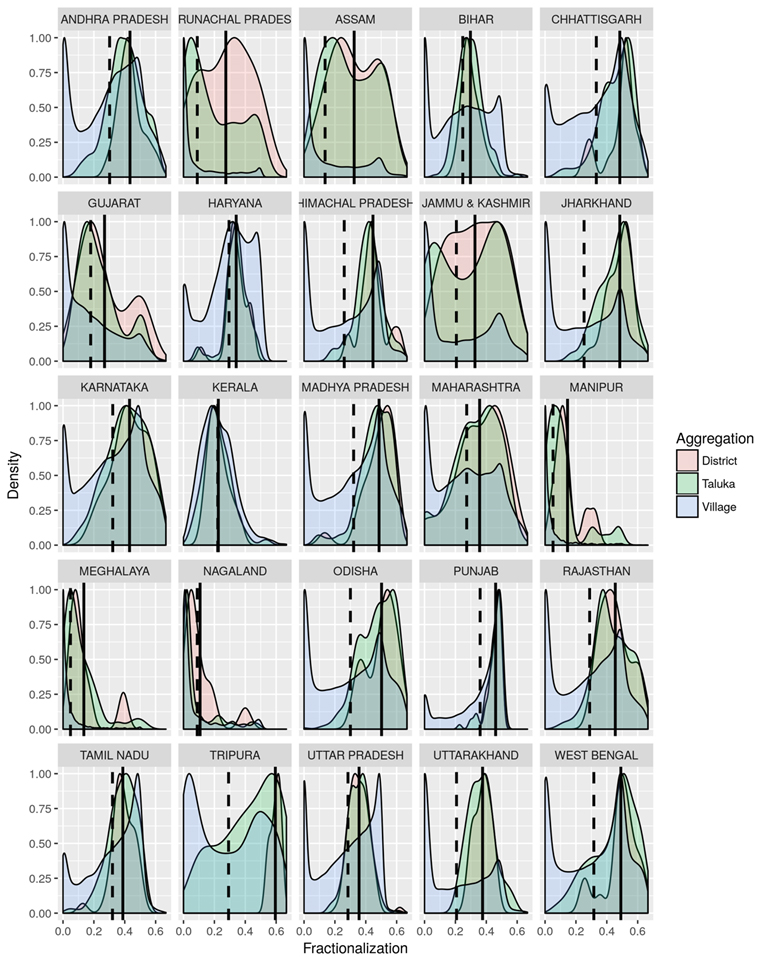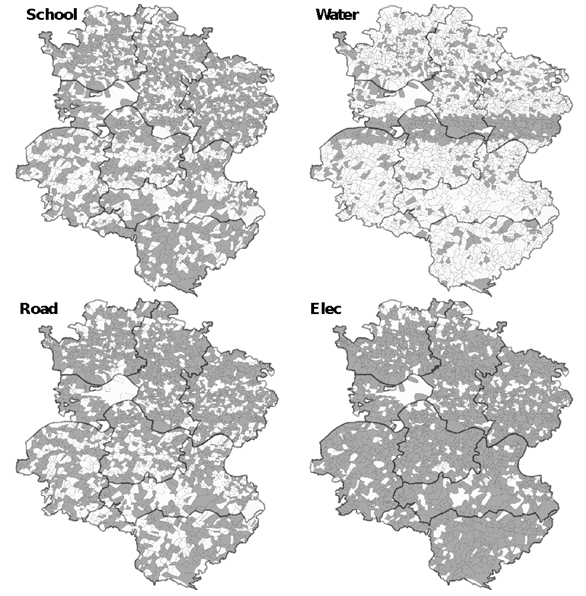Research has shown that regions with higher caste diversity have lower share of villages with essential public goods. This article challenges this finding and shows that empirical models estimated at higher levels of geographical aggregation mask a considerable amount of variation. Any meaningful statistical relationship between diversity and public goods needs to be sensitive to geographical scale as the nature of local politics plays an important role.
The detrimental effect of ethnolinguistic, religious, or racial diversity on development outcomes is regarded as one of the most powerful hypotheses in the field of political economy. The influential work of Banerjee and Somanathan (2007) lends credence to this argument in the context of caste divisions in rural India. Using parliamentary constituency data, they show that regions with higher caste diversity had lower share of villages with essential public goods like tapped water, educational services, etc.
We challenge this finding in our research, and show that empirical models estimated at higher levels of aggregation, say a district, parliamentary, or even assembly constituency, mask a considerable amount of variation, which affects the statistical inference we are able to draw (Bharathi et al. 2020). We argue that any meaningful statistical relationship between diversity and public goods needs to be sensitive to geographical scale for two reasons. First, development outcomes such as the provision of public goods, essentially hinge upon the nature of local politics. Second, the use of local public goods aggregated at a higher spatial scale, as an outcome variable leads to the issue of statistical inference, known as the modifiable areal unit problem (MAUP).
Political salience of spatial scale
The effects of group diversity depend upon the spatial scale at which it is measured. The ‘diversity-deficit hypothesis' initially emerged from cross-country regression models, which found a negative relationship between diversity and economic performance (Alesina and La Ferrara 2005, Easterly and Levine 1997). The relevance of these findings, however, has been questioned at the subnational level (Gerring et al. 2015, Gisselquist et al. 2016, Reynal-Querol and Montalvo 2016). When it comes to top-down State-provided public goods, most empirical studies have not accounted for the fact that the politics of service provision is essentially driven by the nature of State-citizen interaction (Auerbach and Kruks-Wisner 2020). Both local-level diversity – which affects social cohesion – and top-down State provisioning, work in unison to create spatial variation in local public goods.
Such disparities are fairly common in developing countries such as India, where local public goods are provided by the government in a decentralised manner. Often, a tendency for in-group favouritism and out-group discrimination abets these spatial variations. There is substantial evidence for preferential treatment of own villages and caste by members of gram panchayats (GPs) who have considerable discretion in the placement of public goods such as piped water, school or health centres (Besley et al. 2004, Besley et al. 2012, Lee 2017). Aggregating village-level public goods into larger spatial aggregates – as is often done in the literature – therefore does not reflect the nature of local politics, nor the extent of spatial variation at the local level.
Diversity at higher level conceals much of the spatial variation
Besides the local nature of the public good-provisioning politics, aggregating group diversity or the presence of public goods – as common in the literature – masks intra-unit spatial variation that could substantially affect the statistical inference we draw from econometric models. Consider the variation in caste-based diversity, as measured by the fractionalisation index1 using Census data on population shares of scheduled castes (SCs), scheduled tribes (STs), and other castes (OTH), at three administrative levels in rural India – village, sub-districts (taluka), and districts, in Figure 1. Not only does the distribution of diversity vary across states, but as we go to higher spatial resolutions, the distribution suggests a very high level of segregation at the local level – districts and talukas exhibit higher levels of segregation than villages. The diversity metric, as a result, at the district or sub-district level does not adequately capture how the various caste groups interact and coordinate – an aspect central to the diversity-deficit hypothesis – to lobby for local public goods from the government.
Figure 1. State-wise distribution plots for fractionalisation, by geographic aggregations
The MAUP concerns emerge not only through how the diversity measure varies by scale but also how public goods themselves are unequally distributed across villages, even within a sub-district. The empirical literature on India defines the public goods variable as the percentage of villages containing the given public good(s) in a district, or parliamentary constituency (Banerjee and Somanathan 2007). We use an illustrative exhibit from the district, Allahabad in the state of Uttar Pradesh to make this point in Figure 2. From the figure, it is evident that the provision of all the four essential public goods – school, water, electricity, and roads – exhibits a very high degree of spatial variation across villages – even within the sub-districts – as represented by thicker boundaries.
Figure 2. Public good across villages, within the sub-districts of Allahabad
Constructing any metric of public goods at higher administrative aggregates therefore, may not convey any local spatial clustering, which is often the case where public officials and elected representatives have discretionary powers. Greater public goods in the large villages or those belonging to upper-caste groups, elected representatives’ own-constituency, or panchayat headquarters, is well-known which suggests that the process is non-random thereby leading to spatial variations locally.
‘Scale flip’
The salience of spatial scale and the concerns of MAUP in studying the diversity-development association is further verified through regression models across the three geographic aggregates for India. In line with our arguments, we find that the association between caste diversity and public goods is indeed contingent on the level of spatial aggregation. The results of the analysis are presented in Table 1, which shows that there is no robust association between public goods and caste fractionalisation at the larger geographic aggregates (district or sub-district), but at the village level, diversity has a positive association with public goods. We term this result as 'scale flip’. Scale flip, or the instability of results across spatial scales, we argue, is driven by the MAUP, which has been a blind spot in the political economy literature.
Table 1. Association between public goods and caste fractionalisation
|
|
District |
Sub-district |
Village |
|
Primary school |
-0.03 |
-0.07** |
0.05** |
|
Tap water |
-0.16* |
0.01 |
0.03** |
|
Paved road |
0.04 |
0.03 |
0.07** |
|
Electricity |
0.08 |
0.10*** |
0.03*** |
Notes: (i) Outcome variables for columns (1) and (2): Share of villages with access to different facilities. The analysis accounts for Log population, share of SC/ST, literacy rate, number of villages, sex ratio, and workforce participation rate. (ii) Outcome variables for column (3): Whether a village has access to different facilities. The analysis accounts for Log population, share of SC/ST, literacy rate, sex ratio, workforce participation rate. (iii) + p < 0.10, * p < 0.05, ** p < 0.01, *** p < 0.001. Robust standard errors are reported in the parentheses.
Diversity dividend at the local level
Our findings that caste diversity at the village level is positively associated with public goods is supported by related studies. Despite the caste divisions, daily village life does not represent a state of constant conflict. Skill complementarity among caste groups – linked to their hereditary occupation – results in greater trade possibilities, fostering greater inter-group coordination (Jha 2013). Caste dynamics at the village level, therefore, are reciprocal, even if unequal. In recent times, the decentralised system of panchayati raj has brought the State closer to the citizens and hence, the local elite capture of policy preferences has been relatively subdued. Affirmative action such as quotas for lower castes in the panchayats have given voice to the marginalised groups to exercise their voice and participate in solving the coordination problems. (Ban et al. 2012).
Conclusion
Our analysis at multiple geographic scales (village, sub-district, and district) shows that the association between caste diversity and public goods is sensitive to the geographical unit level of analysis. Districts or other such large spatial aggregates, as often used in the literature to study the association between public goods and diversity, therefore, may not be a good choice when local public goods are provided in a decentralised manner. In contrast to the earlier findings, we find that diversity leads to a positive effect at the village level.
I4I is now on Telegram. Please click here (@Ideas4India) to subscribe to our channel for quick updates on our content.
Note:
- 1. The fractionalisation index is the most standard measure to compute diversity. It ranges between 0 and 1 and represents the probability that two different individuals picked at random would belong to two different communities, here SC/ST and OTH.
Further Reading
- Alesina, Alberto and Eliana La Ferrara (2005), “Ethnic Diversity and Economic Performance” Journal of Economic Literature, 43(3): 762–800. Available here.
- Auerbach, Adam Michael and Gabrielle Kruks-Wisner (2020), “The Geography of Citizenship Practice: How the Poor Engage the State in Rural and Urban India”, Perspectives on Politics 1–17.
- Auerbach, AM and G Kruks-Wisner (2020), “Citizen-State relations: Countryside and city”, Ideas for India, 24 August.
- Ban, Radu, Saumitra Jha and Vijayendra Rao, (2012), “Who Has Voice in a Deliberative Democracy? Evidence from Transcripts of Village Parliaments in South India”, Journal of Development Economics, 99(2): 428–38.
- Banerjee, Abhijit and Rohini Somanathan (2007), “The Political Economy of Public Goods: Some Evidence from India”, Journal of Development Economics, 82(2): 287–314.
- Besley, Timothy, Rohini Pande, Lupin Rahman and Vijayendra Rao (2004), “The Politics of Public Good Provision: Evidence from Indian Local Governments”, Journal of the European Economic Association, 2(2–3): 416–26. Available here.
- Besley, Timothy, Rohini Pande and Vijayendra Rao (2012), “Just Rewards? Local Politics and Public Resource Allocation in South India”, The World Bank Economic Review, 26(2): 191–216.
- Bharathi, Naveen, Deepak Malghan, Sumit Mishra and Andaleeb Rahman (2020), “Diversity Deficit and Scale-Flip”, The Journal of Development Studies, 1–19.
- Easterly, William and Ross Levine (1997), “Africa’s Growth Tragedy: Policies and Ethnic Divisions”, Quarterly Journal of Economics, 112(4):1203–50. Available here.
- Gerring, John, Strom C Thacker, Yuan Lu and Wei Huang (2015), “Does Diversity Impair Human Development? A Multi-Level Test of the Diversity Debit Hypothesis”, World Development, 66: 166–88.
- Gisselquist, Rachel M, Stefan Leiderer and Miguel Niño Zarazúa (2016), “Ethnic Heterogeneity and Public Goods Provision in Zambia: Evidence of a Subnational ‘Diversity Dividend’”, World Development, 78:308–23.
- Jha, Sumitra (2013), “Trade, Institutions, and Ethnic Tolerance: Evidence from South Asia”, American Political Science Review, 107(4):806–32.
- Lee, Alexander (2017), “Ethnic Diversity and Ethnic Discrimination: Explaining Local Public Goods Provision”, Comparative Political Studies, 10(51): 1351–83.
- Reynal-Querol, Marta and Jose G. Montalvo (2016), “Ethnic Diversity and Growth: Revisiting the Evidence”, NBER Summer Conference 2016.




 23 November, 2020
23 November, 2020 









Comments will be held for moderation. Your contact information will not be made public.